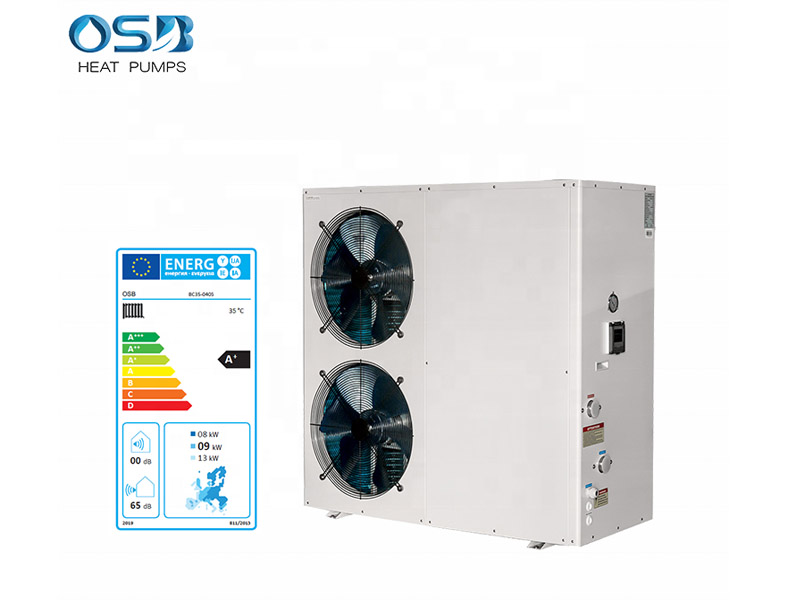
Low-cost electric-powered space heating that can be suitable for off-gas properties, or for very well insulated new-build homes
Air source heat pumps are a kind of renewable energy technology which take the warmth from the air outside (even when it’s quite cold) and use it to heat the home. You can also get heat pumps that do the same thing using the warmth in the ground, but air source heat pumps tend to be suitable for a wider range of properties.
And because the air (or ground) is heated by the sun, the energy that heat pumps produce is still classed as ‘renewable’, even though the pump itself is powered by electricity.
There are two types of air source heat pump. Air-to-water systems heat water which is then circulated around the home via radiators or an underfloor heating system. They can also be used to heat water in a storage tank for the bathroom or kitchen. Air-to-air systems typically use fans to circulate warm air around the home and cannot be used to heat water.
How do they work?
Using various pieces of technical wizardry – namely an evaporator coil full of refrigerant fluid, a type of pump called a compressor and a heat exchanger – heat pumps absorb the warmth in the air outside and release this heat into air or water, which is then distributed around the home. They can do this even when the temperature outside is very low. Fridges work in the same way, only in reverse. They use the same bag of tricks to draw heat out of the air in the fridge, which is why the space behind fridges feels warm.
The efficiency of a heat pump is measured by what is known as the Coefficient of Performance (CoP). This describes the maximum efficiency of a heat pump; the higher the CoP, the better. A heat pump with a CoP of 3 generates three units of heat for every unit of electricity it uses. A typical domestic air source heat pump has a CoP of 2 or 3, but remember this is its maximum efficiency; the actual ratio of ‘electricity in’ to ‘heat out’ over the course of a year will be a bit less.
Where do air source heat pumps work best?
Heat pumps make the most financial sense in properties which are off the gas grid and which therefore use expensive fuels like electricity, oil, LPG or coal for space heating. If you’re connected to mains gas, then you’ll probably be better off with gas central heating.
A well insulated home with high standards of air-tightness is also preferable. This is because heat pumps are most effective in homes which warm up quickly and are good at keeping heat in.
Heating systems powered by heat pumps operate at a lower temperature than ‘normal’ systems, so they need a distribution system that delivers heat over a larger surface area. Radiators connected to heat-pump systems tend to be big, but not very hot. Underfloor heating systems work particularly well with a heat pump.
But in all cases, improving the eneregy efficiency of your home first will help you reduce your heating needs and in turn enable you to run a smaller and cheaper heat pump.
Finally, bear in mind that whilst the unit itself doesn’t take up a lot of space, they need to be positioned somewhere with adequate air flow. A space of approximately 2m2 is required, and this can be in a well ventilated loft as well as outside.
Integration with other renewable energy sources
Although an air source heat pump can usually meet the heating and hot water needs of an average household, you may also consider a back-up supplementary system, for example a solar thermal hot water system and a wood pellet, chip or log stove could be integrated well. Solar water heating may provide all your domestic hot water needs during summer removing the need to run the heat pump at all, and so saving yourself the cost of the electricity.
Cost
The cost of an air source heat pump unit can range from £6,000 to £8,000 and will depend on the size of the property it needs to heat. On top of this is the cost of the installation and of additional works required to upgrade the distribution system. (Generally speaking installing a heat pump is not especially disruptive work, though you may want to carry out this work at the same time as other home renovations.)
The running costs of an installed system will also vary depending on how much heat it needs to produce, what type of distribution system you have and the CoP of the system (see above). The cost of the electricity used to run the heat pump for a typical two-bedroom home is around £900-£1,200 per year, and up to £1,800-£2,400 for a four-bed home. This is generally cheaper than the cost of heating with electricity, oil, LPG or coal but more expensive than gas.
Maintenance costs for air source heat pumps are low. They are reliable, work automatically and have a long life.
Remark:
If you‘re interesting in heat pump products,please feel free to contact OSB heat pump.
Some of the articles are taken from the Internet. If there is any infringement, please contact us to delete it.

